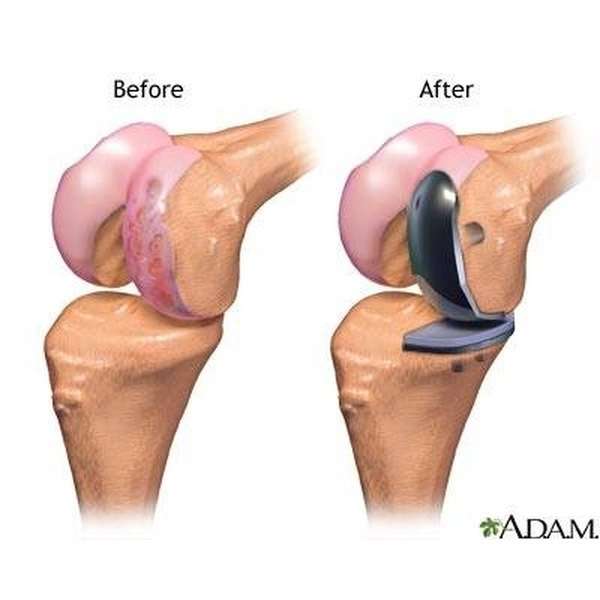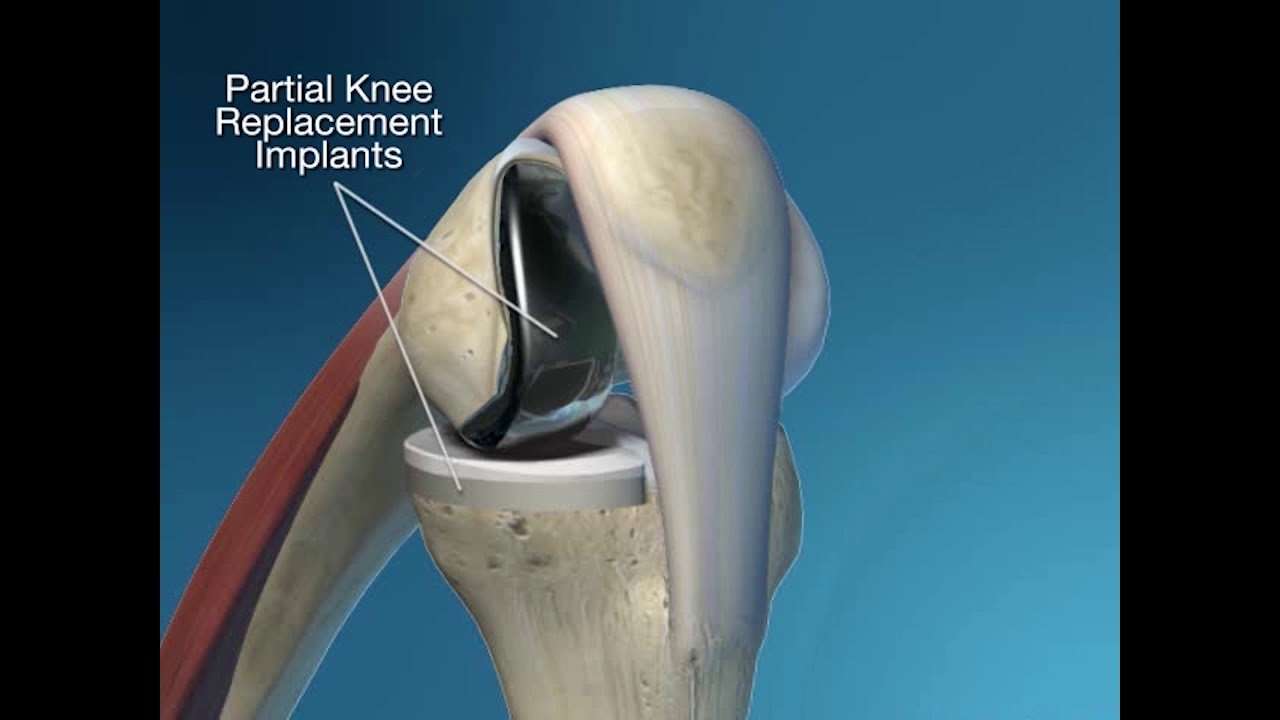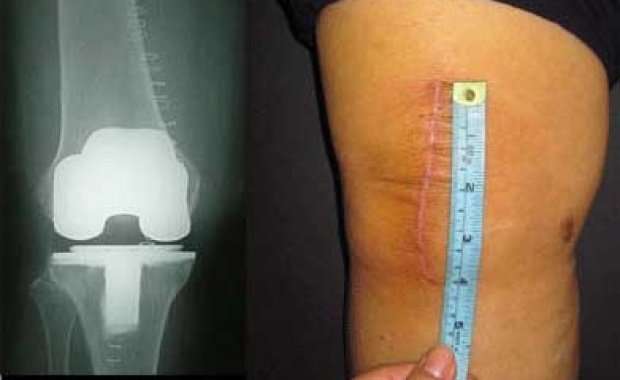Why Is Partial Knee Replacement Performed
The most common reason for partial knee replacement is single-compartmental knee damage from advanced osteoarthritissignificant wear and tear on the knee joint. People with knee have damaged cartilage, which is the shock absorber in joints. When the cartilage begins to wear out, the joint movements arent as smooth, and the bones begin to rub against each other causing pain and stiffness. Knee replacement is a treatment option for most people after a course of nonsurgical treatments arent successful at relieving the pain and discomfort or your symptoms are interfering with your daily activities. The goal of knee replacement is to make knee movement pain-free, smooth and stable.
Although total knee replacement is a common procedure, people who have arthritic damage in only a single part, or compartment of the knee may be good candidates for partial knee replacement surgery. The medical terms for the different compartments are medial , lateral , and patellofemoral .
One of the main benefits of partial knee replacement is the preservation of healthy cartilage, bone and ligaments in the unaffected parts of the knee. It is usually a minimally invasive operation with smaller incision instead of one larger one for open knee replacement. With a half-knee replacementoften the medial sidethere is a possibility of further wear and tear on the other half. This would require replacing the entire knee joint in another surgery.
How Is Partial Knee Replacement Performed
You will have surgery in a hospital or orthopedic specialty surgery center. Before your surgery date, discuss your anesthesia options with your surgeon. You may have a choice of regional anesthesia, which is when you are awake but numb from the waist down. The surgical team will most likely give you a sedative to make you groggy and relaxed during the procedure. The other option is to be completely asleep using general anesthesia.
The will make a cut in your knee about three to five inches long to ensure the damage is confined to just one part of your knee. Typically, knee imaging beforehand will determine the extent of damage, but if there is more damage to the knee than expected, you may need a total knee replacement instead. Your surgeon should discuss this possibility with you in advance.
Partial knee replacement surgery is less invasive than total knee replacement, and the recovery is much quicker and easier. Youll be able to start moving again right away. Depending on your overall health and how you fare after surgery, you may have a hospital stay of only one to two days.
Advantages Of Partial Knee Replacement
Multiple studies have shown that modern unicompartmental knee replacement performs very well in the vast majority of patients who are appropriate candidates.
The advantages of partial knee replacement over total knee replacement include:
- Quicker recovery
- Less pain after surgery
- Less blood loss
Also, because the bone, cartilage, and ligaments in the healthy parts of the knee are kept, most patients report that a unicompartmental knee replacement feels more “natural” than a total knee replacement. A unicompartmental knee may also bend better.
You May Like: How To Pop Your Knee
How Much Weight Can Be Put On The New Knee
Knee replacement patients are given weight-bearing guidelines to follow in the hospital and at home. Exactly how much pressure the new knee can initially support will depend on factors such as:
- The type of surgery preformed
- The type of prostheses and how it is fixated to the natural bone
- The condition of the patients natural bone
Over time, patients will be asked to put incrementally more weight on the new knee.
Knee Replacement Pain After Three Months

Swelling and bruising can continue for three months or more following knee replacement surgery. However, it varies from patient to patient and depends on the condition you were in before surgery. Many patients are back to their activities without the pain they had before surgery by this stage of recovery.
If you find that any movement or activity is still exceedingly painful after three months, you may be experiencing chronic pain. Chronic pain is defined as pain persisting for three months or longer. Its a condition that affects roughly 20% of knee replacement surgery patients. It can develop and increase in intensity in the weeks and months following surgery. This can have a huge impact on your overall quality of life. Talk to your doctor for help.
Also Check: How Much Does A Total Knee Replacement Cost
Ial Knee Replacement Recovery
Reviewed by: KPE Medical Review Board
Partial knee replacement recovery will vary from person to person but is generally very good with 92% of partial knee replacements lasting at least twenty years.
If you are about to have a partial knee replacement, be encouraged. People are usually up and about really quickly after surgery and are home within a few days.
You can usually get up the same day as your operation and can start rehab immediately.
Here we will concentrate on recovery from partial knee replacements, looking at short term recovery over the first week and longer term recovery over the first few months. We will also look at what rehab involves and how successful surgery is.
The information here focuses on partial knee replacements, where only one side of the joint is replaced. If you are having a Total Knee Replacement, visit the TKR recovery section instead.
Before Your Knee Replacement Surgery
You will most likely arrive at the hospital on the morning of your scheduled surgery. Be sure to follow all of your surgeons instructions on preparing for surgery:
- Stop eating or drinking 10 hours before surgery.
- If you take a daily medication, ask your knee doctor if you should still take it the morning of surgery.
- At the hospital, your temperature, pulse, breathing, and blood pressure will be checked.
- An IV line will provide fluids and medications needed during surgery.
Don’t Miss: Reduce Swelling After Knee Replacement
Going Home After A Knee Replacement
Youll be able to leave as soon as you can safely walk up and down stairs on crutches, and the healthcare team are happy you are medically fit this is usually around day 4 or 5. You wont be able to drive, so youll need someone to come and take you home.
Well train you to manage stairs in the following way:
Find out more about getting out of the car with crutches and getting into bed with crutches.
Here Is An Overview Of What You Can Expect During These 12 Weeks:
- Days 1 3: In the hospital, you will work with a physical therapist and occupational therapist to work on straightening and bending the knee.
- Discharge Day: Most people are discharged from the hospital within a few days. You will be sent home with specific instructions for care, medication, and therapy.
- Week 3: By the time you reach week three, you will be able to move around a little more, and the pain will be decreasing.
- Weeks 4 6: The most noticeable improvements in your knee happen during this time if you are consistent with your rehab and exercise activities.
- Weeks 7 11: Physical therapy and rehabilitation continue. At this point, you will be working on range of motion, mobility, and strengthening the muscles.
- Week 12: You can start to return to normal activities but still need to avoid high-impact exercise .
Beyond this initial recovery time, you will notice that the pain will continue to decrease, and your function will improve.
Also Check: Why Do My Knees Crack When I Squat
What To Expect 3 Weeks After Knee Replacement Surgery
Three weeks after knee replacement surgery, you might be either walking with a walker, with crutches or with a cane. Youll likely experience mild pain and be low on energy. Hopefully by now youll be attending regular physiotherapy appointments to help rehabilitate your knee with your physiotherapists looking to implement more aggressive ROM exercises on your knee.
You wont be able to drive at the 3-week mark, but you might start to be able to return to doing more around the house. Youll probably be able to stand and walk around for about 10 minutes at a time and normal routines like getting dressed will become easier.
How Do You Know If You Need Knee Replacement Surgery
Each patient is unique, which is why it is essential to schedule an examination and testing with an experienced sports medicine doctor. Our team will determine a diagnosis before deciding if you need to schedule a date for surgery. The preference is always to use minimally-invasive treatments first before surgery is necessary.
But there are times when surgery is required. Whether the minimally-invasive treatments arent working, or youve had a severe injury, you might need to schedule surgery to achieve the recovery you desire.
You May Like: Is Nano Knee Covered By Medicare
Knee Replacement Recovery Exercises
Initially, as you increase your activity the knee can be sore, but with appropriate medication and gentle exercise, your recovery should proceed smoothly.
Well prescribe a set of exercises for you to do at home. Every programme is different, but here are a few exercises we regularly ask patients to do. You should aim for 3 sets of 10 reps per exercise every day:
- Stair lunges: Stand at the base of the stairs and place your operated foot on the first stair. Lunge forward slowly bending at the knee only as far as is comfortable
- Bed exercise: Push the knee flat into the bed to fully straighten the leg
- Mini-squats: Stabilise yourself by holding on to a kitchen bench, door frame or heavy table. Keeping your back straight, lower you buttocks bending, at the knees. Only go as far as is comfortable.
How Long Does It Take To Recover From A Total Knee Replacement A Surgeons Timeline

Published on: 19th December 2018
A few weeks ago, Channel 5 aired a documentary called Operation Live: Total Knee Replacement. Did you catch it?
It caused quite a stir, mainly due to its no-holds-barred content. As the title implies, the programme featured live coverage of a patient undergoing a total knee replacement at the Royal London Hospital. You can see it on catch-up here , though do exercise viewing caution, for obvious reasons.
For anyone who works with Total Knee Replacements or is considering one, Operation Live was a fascinating watch. It wasnt for the squeamish. But that was the key take-home point: for all its great benefits, TKR does take significant recovery time. More than many patients realise.
So what does that look like in practice? Keep in mind that recovery times vary from person to person, but here is a general guide.
You May Like: Remove Scar Tissue From Knee
Knee Replacement Recovery Time: First 3 Months
For 6-8 weeks after knee replacement surgery you should avoid:
- Any pivoting on your knee
- Kneeling
- Squatting
You will need to continue with your knee replacement rehab programme for at least 3 months after knee replacement surgery, probably six months to get the best result from your operation.
You will be able to progress your exercises as your knee gets stronger and more flexible. Visit the rehab section to find out more. The more you stick to your exercise programme, the quicker your knee replacement recovery is likely be.
Time Off Work After A Knee Replacement
Its important to take time off to rest, but getting back to your routine as soon as possible can help you recover faster. If you have a desk job, youll be able to return to work after around 8 weeks. If you job is more physically demanding, youll need to wait around 12 weeks. If youre not sure, check with your doctor.
Recommended Reading: How To Get Rid Of Dark Knees And Elbows
How Much Should You Walk After A Knee Replacement
After you have recovered from your knee replacement surgery, you should be able to walk normally with minimal pain or no pain at all. Youll likely be able to return to your normal activities.
Its crucial is to take your time during the recovery process, complete all of your physiotherapy, and wait until your knee is fully recovered before doing all the things you used to do pre-surgery.
Make sure to get the ok from your doctor or physiotherapist before returning to any activities.
Pending on your recovery and your own situation it might be recommend that you exercise for 20 to 30 minutes, 2 or 3 times a day and walk for 30 minutes, 2 or 3 times a day during your early recovery Orthoinofo
Who Can Benefit From Partial Knee Replacement
Partial knee replacement is appropriate for patients with arthritis that is confined to a single compartment of the knee and is generally restricted to patients who are not morbidly obese. The surgery is not appropriate for patients with marked stiffness in the knee or those with a significant angular deformity. Intact ligaments are generally a requirement for a partial knee replacement. Patients with are not candidates for partial knee solutions since inflammatory-type arthritis typically involves the entire joint.
Additional considerations are evaluated on a case-by-case basis with the surgeon and patient determining together whether partial knee replacement is the best treatment option. Selecting the right patient is considered one of the most important steps to ensuring a good functional outcome and longevity for a partial knee replacement.
Read Also: Scar Tissue Removal Surgery Knee
Managing Your Recovery At Home
To begin with, its normal to experience:
- tiredness get plenty of rest, but then its important to slowly increase your activity
- swelling to ease this, keep your leg raised when sitting and use the cryocuff cold compress we gave you, or apply an ice pack wrapped in a tea towel
- pain take any painkillers weve prescribed until youre pain free
Here are a few things you can do to strengthen your knee, avoid damaging it and help your wound heal:
- Keep your wound dry for 45 days afterwards, and use a waterproof dressing when you have a bath or shower
- Continue the exercises the physiotherapist showed you
- Try low-impact activities like walking and gradually increase how far you walk
- Keep using your crutches or walking stick for as long as you feel you need to
- Dont lift anything heavy or do any strenuous exercise
- Youll be able to bend your knee 90-120 degrees, but you should avoid kneeling down
- Dont sit with your legs crossed for the first 6 weeks
- Avoid twisting at your knee
Will I Be Able To Bend Down On My Knee After A Partial Knee Replacement
As part of your rehabilitation at Summit Healthcare, we will include training you how to kneel on your repaired knee. This is a completely safe movement and patients usually only stop kneeling out of fear of damaging their repaired knee. The problem with this overly restrictive line of recovery is that kneeling is important for many movements and activities. For instance, older patients need to be able to get up off the floor in case of a fall. If they cannot kneel, they cannot get back up. Other activities from gardening to household chores require kneeling. You will not need to lose this ability because of your partial knee replacement.
Read Also: What Will The Er Do For A Knee Injury
How Long Will It Take To Recover After The Surgery
Most people leave hospital 1-4 days after a knee replacement surgery. How quickly you get back to normal depends on many factors, including your age and general health and fitness.
You will probably need a cane, crutches or walking frame in the first few weeks and an exercise and physiotherapy program to help you recover.
Most people’s strength and flexibility slowly recovers over about 12 months. Following the advice of a physiotherapist and doing rehabilitation exercises as instructed makes the recovery quicker.
Are You The Right Candidate For Partial Knee Replacement

There are many things one has to meet to become a perfect candidate for partial knee replacement. Take a look.
Less Success with Non-Surgical Treatments
If you havent found relief with the standard non-surgical treatments for your knee pain this options is best. The non-surgical treatments that I am referring to here include the following options.
- Oral medications
- Weight loss in obesity
Don’t Miss: How To Break Up Scar Tissue In Knee
Why Is Partial Knee Replacement Popular
Previously, partial knee replacement was in fact, reserved for senior patients since they were less active. Today, it is favored for the younger generation too. Here is the reason why it is this popular.
Shorter Recovery Timeline
Partial knee replacement recovery time is shorter. Thanks to its minimally invasive nature which requires less time to heal.
Lesser Pain
For young patients, the recovery timeline is not only quicker but also less painful. This is contrary to full surgery.
Very Much Affordable Too
Compared to total knee replacement surgery, partial surgery is also quite affordable. This is because it is less demanding.
Success Rate
Apart from its knee replacement surgery recovery time the success rate is also high. This means that it is much more effective.
Less Blood Loss
Partial knee surgery uses very small dissection which leads to less loss of blood. Because of this, no blood transfusion is often needed and most patients find it easy to undergo the whole process.
NOTE: The idea of a partial knee replacement surgery is to remove the most damaged areas of the cartilage from the knee joint and maintain healthy parts for continued use.